Biel/Bienne
| Biel/Bienne | ||
|---|---|---|
|
Old Town of Bienne | ||
| ||
 Biel/Bienne | ||
|
Location of Biel/Bienne 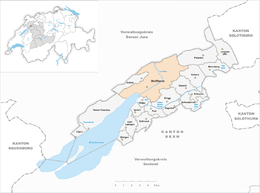 | ||
| Coordinates: 47°08′N 7°15′E / 47.133°N 7.250°ECoordinates: 47°08′N 7°15′E / 47.133°N 7.250°E | ||
| Country | Switzerland | |
| Canton | Bern | |
| District | Biel/Bienne | |
| Government | ||
| • Executive |
Gemeinderat/Conseil municipal with 5 members | |
| • Mayor |
Stadtpräsident/le Maire (list) Erich Fehr SPS/PSS (as of February 2011) | |
| • Parliament |
Stadtrat/Conseil de ville with 60 members | |
| Area[1] | ||
| • Total | 21.23 km2 (8.20 sq mi) | |
| Elevation (Railway station) | 437 m (1,434 ft) | |
| Population (Dec 2015[2]) | ||
| • Total | 54,163 | |
| • Density | 2,600/km2 (6,600/sq mi) | |
| Demonym(s) | French: Biennois(e), German: Bieler/in | |
| Postal code | 2500-2510 | |
| SFOS number | 0371 | |
| Surrounded by | Brügg, Ipsach, Leubringen/Magglingen (Evilard/Macolin), Nidau, Orpund, Orvin, Pieterlen, Port, Safnern, Tüscherz-Alfermée, Vauffelin | |
| Twin towns | Iserlohn (Germany) | |
| Website |
www SFSO statistics | |
Biel/Bienne (official bilingual wording; German: [biːl]; French: [bjɛn]; Italian: Bienna, Romansh: Bienna, Latin: Belna) is a town and a municipality in the Biel/Bienne administrative district in the canton of Berne in Switzerland.
Biel/Bienne is on the language boundary between the French-speaking and German-speaking parts of Switzerland, and is throughout bilingual. Biel is the German name for the town, Bienne its French counterpart. The town is often referred to in both languages simultaneously. Since January 1, 2005, the official name has been "Biel/Bienne". Until then, the city was officially named Biel (BE).[3]
The city lies at the foot of the first mountain range of the Jura Mountains area, guarding the only practical connection to Jura in the area, on the northeastern shores of Lake Biel (Bielersee, Lac de Bienne), sharing the eastern tip of the lake with its sister city, Nidau, the administrative centre of the District of Nidau. Neuchâtel, Solothurn, and Berne (the capital of Switzerland) lie west, east and southeast of Biel/Bienne. They all can be reached in about 30 minutes, either by train or by car.
The city has about 55,000 inhabitants and in 2014 the agglomeration had almost 106,000.[4]
History
Prehistoric settlements

The shoreline of Lake Biel has been inhabited since at least the neolithic. The remains of two neolithic settlements were found at Vingelz in 1874. The remains of the settlements became the Vingelz / Hafen archaeological site, which is now part of a UNESCO World Heritage Site. East of the Vingelz site, a late Bronze Age settlement was also discovered.[5] After the Roman conquest, the region was part of Germania Superior. During the Roman era the Roman road from Petinesca to Pierre Pertuis or Salodurum (now Solothurn) passed through the village of Mett, which is now part of Biel/Bienne. The foundations of buildings and a 4th-century cemetery in Mett come from a late Roman or an early medieval military guard station.[6]
A theory holds that the toponym is derived from the name of Belenus, probably from a Roman era sanctuary of that deity at a sacred spring nearby. However, no surviving records or inscriptions confirm this theory. Another theory states that the town grew up around a late Roman fortress. While no trace of the fortress has been found, the foundations of several Roman buildings have been found east of the medieval town.[7]
The town is mentioned in 1142 as apud belnam,[7] which is taken as evidence for its derivation from Belenus. In popular etymology, the name has been connected with the German name for axe (Bernese German bieli), reflected in the two crossed axes in the city's coat of arms.
Foundation of the city


In the 5th century, the area was invaded by the Burgundians, and by the medieval period became part of Upper Burgundy. During the 6th or 7th century, the Germanic speaking Alamanni moved into the area around Lake Biel, creating the language boundary that exists today. By the 8th century, the German-speaking population became the majority on the east end of the lake. In 999 Rudolph III of Burgundy granted lands around Lake Biel to the Bishopric of Basel, during the formative period of the Holy Roman Empire. Through the Bishop of Basel, the Counts of Neuchâtel and later the Counts of Neuchâtel-Nidau began to exercise their power in the foothills of the Jura Mountains. In 1140 the counts built Nidau Castle in the neighboring village of Nidau to help secure their land on the eastern end of the lake. The town was probably built by the Bishop of Basel, Heinrich II von Thun, between 1225 (mention of domum de Bilne) and 1230 (mention of in urbe mea de Beuna). Biel Castle was built either shortly before or shortly after the foundation of the town, to help support Nidau Castle.[7]
Officially, Biel remained under the jurisdiction of the Bishop of Basel throughout the 11th to 18th centuries. However, the early history of the town is filled with conflict between the town council and the Bishop's representative. In 1252, the town council partly succeeded in becoming a free imperial city. In 1275 King of Germany Rudolph of Habsburg granted Biel a town charter. The town's legal position was strengthened in 1296 when Bishop Peter Reich von Reichenstein signed an agreement with the town. This original agreement was strengthened in 1352 and remained in force until 1798.
The town's church, the Church of St. Benedict, was first mentioned in 1228. The current church was built in 1451-70 and is regarded, after Berne Cathedral, as the second most important late gothic building in the Canton of Bern.[7]
An associate of the Swiss Confederation
While it officially remained part of the lands of the Prince-Bishopric of Basel, starting in the 13th century Biel began making alliances with neighboring nobles and cities. In 1279 it allied with Bern. This first alliance was followed in 1311 by an alliance with Fribourg, a 1334 alliance with Solothurn, 1342 with Murten and 1395 with La Neuveville. The alliance with Bern became an eternal alliance in 1352, as Bern itself joined the Old Swiss Confederacy. Contradictory obligations to the Bishop of Basel and Bern led to a war in 1367. During the war, Biel was burned and the Bishop's castle was destroyed. After the extinction of the Counts of Neuchâtel-Nidau in 1375 the Bishop's power around the lake began to wane. In 1388, Bern gained control of Nidau Castle and the town of Nidau. However, the Bishop retained nominal power and influence in Biel. The two competing powers struggled for power in Biel for over 400 years and prevented the town from becoming completely independent from either powerful neighbor.[7]
Biel was considered an associate of the Swiss Confederacy during the 15th century, and after its participation in the Burgundy Wars even came to be recognized as a full member by 1494.
Even though Biel remained nominally under the control of the Catholic Bishops of Basel, in 1528 it converted to the new Protestant faith.
From the French invasion to modern Biel/Bienne


The French Revolution changed the political situation in Biel/Bienne. In 1793, the French Revolutionary Army captured the Bishopric of Basel and brought the French into the lands near Biel. When they conquered the Moutier valley and Erguel in 1797 it brought the French practically to the gates of Biel/Bienne. On 6 February 1798, French troops marched through the open city gate while the population celebrated their arrival. Bienne and its neighboring communities were incorporated as the "Canton de Bienne" into the département du Mont-Terrible of the First French Republic. Two years later, in 1800, it went to the Département du Haut-Rhin. Under Mayor Sigmund Wildermeth (1765-1847) Biel strictly followed every dictate from Paris.
After the collapse of the French Empire, Biel sent Georg Friedrich Heilmann to the Congress of Vienna in 1814 to push for the creation of an independent Canton of Biel. However, he was unsuccessful and the Congress granted most of the territory of the Bishopric to the canton of Bern. Biel was able to resist unification until Bern agreed to retain some of Biel's historic privileges and rights. In 1815 Biel finally joined the Canton of Bern as part of the Oberamt of Nidau. The city council of Biel struggled to make it the capital of its own district. Finally in 1832 the Biel Amtsbezirk was created and Biel became the district capital. The democratic reforms of the Regeneration era helped the citizens of Biel to identify with and feel a part of the Canton of Bern.[7]
By the beginning of the 20th century anarcho-syndicalist groups, which saw strikes and sabotage as legitimate means to bring about reform, began to influence the labor movement in Biel. The first large scale strike was the construction workers strike of 1902. The following years were marked with bitterly fought labor disputes. The largest strike was the journeymen carpenters strike of 1907, which lasted almost a year. Also in 1907 labor secretary Gottfried Reimann from the Social Democratic Party was elected mayor. His election marked the first time that a Social Democrat was elected to such a powerful office in Switzerland.
The First World War meant a setback for the labor movement, even though Switzerland was not directly involved in the war. Wages were reduced significantly when the war started while inflation made everything more expensive. In July 1918, a demonstration of starving workers erupted into street riots that required military action to suppress.
In 1919 a Communist Party was founded in Biel, but it remained a minor party in the city. In 1921, the Social Democrats won a slim majority in the city councils. Under the leadership of the Social Democratic Mayor Guido Müller "Red Biel" began a series of socialist community experiments. During the 1930s the entire neighborhood around the train station was redeveloped according to the social planning theories of the era. The Volkshaus (People's House), built under the direction of Edward Lanz between 1928–32, is an example of the "new building" style and a symbol of the Social Democratic era of the city.
In the years leading up to the Second World War, the Social Democrats began to lose power in the city. In the last year of the war, the Swiss Party of Labour gained nine seats on the city council and ended the Social Democrat majority. With the resignation of Mayor Müller in 1947, it would be almost thirty years (1976) before the Social Democrats had another mayor in Biel.[7]
On the occasion of the secession of the canton of Jura in 1978, Biel had been asked to become its capital, but it remained with the canton of Bern.
The town was officially named Biel until 2004, even though the bilingual Biel-Bienne was in common use. Since 2005, the official name has been Biel/Bienne, with forward slash.[8]
At the beginning of the 20th century, the town's population was at 30,000 people. It doubled over the next 60 years, peaking at 65,000 in the mid-1960s. It declined gradually over the 1970s to 1990s, to below 49,000 in 2000, again rising slightly to just over 50,000 during the 2000s. Another 89,000 people live in the immediately surrounding urban agglomeration.
Geography and climate
Topology

Biel/Bienne has an area of 21.23 km2 (8.20 sq mi).[1] Of this area, 1.7 km2 (0.66 sq mi) or 8.0% is used for agricultural purposes, while 9.63 km2 (3.72 sq mi) or 45.4% is forested. Of the rest of the land, 9.65 km2 (3.73 sq mi) or 45.5% is settled (buildings or roads), 0.13 km2 (32 acres) or 0.6% is either rivers or lakes and 0.14 km2 (35 acres) or 0.7% is unproductive land.[9]
Of the built up area, industrial buildings made up 5.1% of the total area while housing and buildings made up 21.9% and transportation infrastructure made up 12.6%. Power and water infrastructure as well as other special developed areas made up 1.7% of the area while parks, green belts and sports fields made up 4.1%. Out of the forested land, all of the forested land area is covered with heavy forests. Of the agricultural land, 4.7% is used for growing crops and 2.0% is pastures. All the water in the municipality is flowing water.[9]
The municipality is at the southern foot of the Jura Mountains on the east end of Biel Lake. It consists of the village of Biel/Bienne, Vingelz (since 1900), Bözingen (since 1917), Madretsch and Mett (both since 1920).
On 31 December 2009 Amtsbezirk Biel, the municipality's former district, was dissolved. On the following day, 1 January 2010, it joined the newly created Verwaltungskreis Biel/Bienne. It remained the capital of the new Verwaltungskreis.[3]
Climate
| Climate data for Biel/Bienne (1981-2010) | |||||||||||||
|---|---|---|---|---|---|---|---|---|---|---|---|---|---|
| Month | Jan | Feb | Mar | Apr | May | Jun | Jul | Aug | Sep | Oct | Nov | Dec | Year |
| Average high °C (°F) | 3.7 (38.7) |
5.6 (42.1) |
10.7 (51.3) |
14.9 (58.8) |
19.6 (67.3) |
22.9 (73.2) |
25.6 (78.1) |
25.0 (77) |
20.5 (68.9) |
14.7 (58.5) |
8.0 (46.4) |
4.7 (40.5) |
14.7 (58.5) |
| Daily mean °C (°F) | 0.7 (33.3) |
1.6 (34.9) |
5.5 (41.9) |
9.5 (49.1) |
14.0 (57.2) |
17.4 (63.3) |
19.7 (67.5) |
18.9 (66) |
14.8 (58.6) |
10.3 (50.5) |
4.8 (40.6) |
1.8 (35.2) |
9.9 (49.8) |
| Average low °C (°F) | −1.5 (29.3) |
−1.4 (29.5) |
1.6 (34.9) |
4.7 (40.5) |
9.1 (48.4) |
12.4 (54.3) |
14.4 (57.9) |
14.0 (57.2) |
10.6 (51.1) |
7.1 (44.8) |
2.2 (36) |
−0.4 (31.3) |
6.1 (43) |
| Average precipitation mm (inches) | 101 (3.98) |
88 (3.46) |
89 (3.5) |
79 (3.11) |
100 (3.94) |
100 (3.94) |
102 (4.02) |
113 (4.45) |
97 (3.82) |
104 (4.09) |
98 (3.86) |
117 (4.61) |
1,187 (46.73) |
| Average snowfall cm (inches) | 14.8 (5.83) |
13.2 (5.2) |
5.6 (2.2) |
0.8 (0.31) |
0 (0) |
0 (0) |
0 (0) |
0 (0) |
0 (0) |
0 (0) |
3.7 (1.46) |
13.6 (5.35) |
51.7 (20.35) |
| Average precipitation days (≥ 1.0 mm) | 10.7 | 10.0 | 10.7 | 10.2 | 12.2 | 10.8 | 10.6 | 10.6 | 8.8 | 10.8 | 10.5 | 11.5 | 127.4 |
| Average snowy days (≥ 1.0 cm) | 4.1 | 3.4 | 1.8 | 0.3 | 0 | 0 | 0 | 0 | 0 | 0 | 1 | 2.9 | 13.5 |
| Average relative humidity (%) | 85 | 80 | 73 | 69 | 70 | 69 | 67 | 71 | 76 | 83 | 84 | 85 | 76 |
| Source: MeteoSwiss [10] | |||||||||||||
Politics
Coat of arms
The blazon of the municipal coat of arms is Gules two Axes Argent in saltire.[11]
Government
The Municipal Council (fr: Conseil municipal, de: Gemeinderat) constitutes the executive government of the City of Biel/Bienne and operates as a collegiate authority. It is composed of five councilors (French: Conseiller municipal/ Conseillère municipale, German: Gemeinderat/ Gemeinderätin), each presiding over a directorate. The president of the presidential directorate acts as mayor (fr: Maire, de: Stadtpräsident). In the mandate period 2017–2020 (législature, Legislatur) the Municipal Council is presided by Maire/ Stadtpräsident Erich Fehr. Departmental tasks, coordination measures and implementation of laws decreed by the City Council (parliament) are carried by the Municipal Council. The regular election of the Municipal Council by any inhabitant valid to vote is held every four years. Any resident of Biel/Bienne allowed to vote can be elected as a member of the Municipal Council. The current mandate period is from 1 January 2017 to 31 December 2020. The mayor is elected as such by public election by means of a system of Majorz, while the heads of the other directorates are assigned by the collegiate. The delegates are selected by means of a system of Proporz.[12]
As of 2017, Biel/Bienne's Municipal Council is made up of two representatives of the PS/SP (Social Democratic Party, of whom one is also the mayor), one member of the Grünes Bündnis (GB) (Green Party), one of the PRR (Les Radicaux Romands), and one of the UDC/SVP (Swiss People's Party), giving the left parties a majority of three out of five seats. The last regular election was held on 25 September 2016. All previous delegates have been re-elected.[12]
| Municipal Councillor (Conseiller communal/ Conseillère communale, Stadtrat/ Stadträtin) | Party | Head of Directorate (Directeur/Directrice de, Direktor/Direktorin, since) of | elected since | Native language |
|---|---|---|---|---|
| Erich Fehr[CC 1] | PS | Mayor's Office (mairie/ Präsidialdirektion, 2011) | 2010 | DE |
| Silvia Steidle[CC 2] | PRR | Finance (Direction des finances/ Finanzdirektion, 2009) | 2008 | FR |
| Beat Feurer | SVP | Social Services and Security (Direction de l'action sociale et de la sécurité/ Direktion Soziales und Sicherheit, 2013) | 2012 | DE |
| Cédric Némitz | PSR | Education, Culture, and Sports (Direction de la formation, de la culture et du sport/ Direktion Bildung, Kultur und Sport, 2013) | 2012 | FR |
| Barbara Schweikert | GB | Civil Engineering and Construction, Energy, and Environmental Sustainability (Direction des travaux publics, de l'énergie et de l'environnement/ Direktion Bau, Energie und Umwelt, 2009) | 2008 | DE |
Barbara Labbé is Town Chancellor (chancelière municipale/ Stadtschreiberin) since , and Bertrand Cottier is Deputy Town Chancellor (vice-chancelier, Vize-Stadtschreiber) since for the Municipal Council.
Parliament
The Conseil général/Generalrat of Fribourg for the mandate period of 2016-2021
The City Council (fr: Conseil de ville, de: Stadtrat), the city parliament, holds legislative power. It is made up of 60 members, with elections held every four years. The City Council decrees regulations and by-laws that are executed by the Municipal Council and the administration. The delegates are selected by means of a system of proportional representation.
The sessions of the City Council are public. Unlike members of the Municipal Council, members of the City Council are not politicians by profession, and they are paid a fee based on their attendance. Any resident of Biel/Bienne allowed to vote can be elected as a member of the City Council. The Parliament holds its meetings in the Stadtratssaal.[13]
The last regular election of the City Council was held on 25 September 2016 for the mandate period (la législature) from 2017 to 2020. Currently the City Council consist of 19 members of the Social Democratic Party (PSR/SP) including 7 members of the French branch Partie Socialiste Romands (PSR) and 2 members of its junior parties JUSO/JS, 11 members of the Swiss People's Party (UDC/SVP) including 3 members of the Die Eidgenossen (DE), 10 members of the The Liberals (PRR/FDP) including 4 members if its French branch Partie Radicaux Romands (PRR), 8 members of the Green Party (LV/GB), 4 Green Liberal Party (PVL/GLP), 2 members of the Conservative Democratic Party (PBD/BDP) from Biel/Bienne (BLB), 2 members of the Evangelical People's Party (PEV/EVP), 2 members of the alliance called Passarelle, and one each for the Swiss Party of Labour (POP/PdA and Federal Democratic Union (UDF/EDU).[14]
Elections
National Council
In the 2011 federal election the most popular party was the SPS which received 31.2% of the vote. The next three most popular parties were the SVP (19.9%), the Green Party (14.7%) and the FDP (8.8%). In the federal election, a total of 12,363 votes were cast, and the voter turnout was 39.0%.[15]
International relations
Twin towns — Sister cities
Biel/Bienne is twinned with:
 Iserlohn, Germany since 1959
Iserlohn, Germany since 1959
Demographics
Population

Biel/Bienne has a population (as of December 2015) of 54,163.[16] As of 2010, 28.1% of the population are resident foreign nationals. Over the last 10 years (2000-2010) the population has changed at a rate of 3.8%. Migration accounted for 7.8%, while births and deaths accounted for -1.4%.[17]
Of the population in the municipality, 15,339 or about 31.5% were born in Biel/Bienne and lived there in 2000. There were 8,990 or 18.5% who were born in the same canton, while 9,170 or 18.8% were born somewhere else in Switzerland, and 12,244 or 25.2% were born outside of Switzerland.[18]
As of 2010, children and teenagers (0–19 years old) make up 18.8% of the population, while adults (20–64 years old) make up 61.9% and seniors (over 64 years old) make up 19.3%.[17]
As of 2000, there were 19,980 people who were single and never married in the municipality. There were 21,188 married individuals, 3,727 widows or widowers and 3,760 individuals who are divorced.[18]
As of 2000, there were 11,014 households that consist of only one person and 797 households with five or more people. In 2000, a total of 23,367 apartments (86.8% of the total) were permanently occupied, while 2,169 apartments (8.1%) were seasonally occupied and 1,398 apartments (5.2%) were empty.[19] As of 2010, the construction rate of new housing units was 3.2 new units per 1000 residents.[17]
As of 2003 the average price to rent an average apartment in Biel/Bienne was 935.83 Swiss francs (CHF) per month. The average rate for a one-room apartment was 463.73 CHF, a two-room apartment was about 706.49 CHF, a three-room apartment was about 846.98 CHF and a six or more room apartment cost an average of 1749.16 CHF. The average apartment price in Biel/Bienne was 83.9% of the national average of 1116 CHF.[20] The vacancy rate for the municipality, in 2011, was 2%.
Historic Population
The historical population is given in the following chart:[7]

| Historic Population Data [7] | |||||||||||
|---|---|---|---|---|---|---|---|---|---|---|---|
| Year | Total Population | German Speaking | French Speaking | Catholic | Protestant | Christian Catholic | Jewish | Other religions | No religion given | Swiss | Non-Swiss |
| 1770 | 1,698 | ||||||||||
| 1818 | 3,589 | ||||||||||
| 1850 | 5,609 | 5,268 | 341 | ||||||||
| 1880 | 16,579 | 13,253 | 3,207 | 1,675 | 14,620 | 240 | 77 | 15,323 | 1,289 | ||
| 1910 | 32,136 | 22,017 | 9,209 | 4,840 | 26,366 | 413 | 517 | 28,723 | 3,413 | ||
| 1930 | 37,726 | 24,946 | 11,673 | 6,031 | 30,750 | 310 | 635 | 35,588 | 2,338 | ||
| 1950 | 48,342 | 32,188 | 14,598 | 8,659 | 38,314 | 572 | 268 | 529 | 46,232 | 2,110 | |
| 1970 | 64,333 | 36,354 | 17,396 | 22,745 | 40,032 | 282 | 178 | 1,096 | 52,148 | 12,185 | |
| 1990 | 51,893 | 27,510 | 15,906 | 17,857 | 26,123 | 116 | 69 | 7,728 | 3,959 | 40,576 | 11,317 |
Language

In 2000, a majority of the population spoke German (26,957 or 55.4%) as their first language. French was the second most common (13,695 or 28.1%) and Italian was third (2,925 or 6.0%). There were 37 people who spoke Romansh.[18] The city is officially bilingual (the biggest bilingual city in Switzerland). In addition some 150 nationalities are represented in Biel. In recent years the city has used its linguistic assets as an economic advantage, becoming the Swiss City of Communication. Several call centres have been created in or around Biel, in addition to the traditional businesses established in the city and surrounding area, which have always exported most of their production worldwide.
Religion
According to the 2000 census, 19,191 people or 39.4% of the total population, belonged to the Swiss Reformed Church, while 14,241 or 29.3% were Roman Catholic. Of the rest of the population, there were 613 members of an Orthodox church (or about 1.26% of the population), there were 87 individuals (or about 0.18% of the population) who belonged to the Christian Catholic Church, and there were 2,870 individuals (or about 5.90% of the population) who belonged to another Christian church. There were 61 individuals (or about 0.13% of the population) who were Jewish, and 3,156 (or about 6.49% of the population) who were Muslim. There were 329 individuals who were Buddhist, 235 individuals who were Hindu and 68 individuals who belonged to another church. 6,012 (or about 12.36% of the population) belonged to no church, are agnostic or atheist, and 3,180 individuals (or about 6.54% of the population) did not answer the question.[18]
Tourism

Biel/Bienne is the heart of the Swiss watch-making industry. Trademarks such as Swatch, Omega, Rolex, Bucherer, Candino, Century, Festina, Perrelet, Leroy, and many others are closely associated with the city of Biel, The Swatch Group has its worldwide headquarters in the tree lined "Seevorstadt", in the previous building of ASUAG.
The city has a small and beautiful historic centre, with a gothic church (15th century), impressive guild halls and fountains decorated with flowers. Outside the historic centre, the tree-lined "Seevorstadt" goes to the lake and its beautiful shoreline. On the way the visitors pass the Biel "Cultural Quarter" with the Neuhaus and Schwab Museums and the CentrePasquArt.
The Jura mountains are easily reached by funicular railway from Bienne, with both the Biel/Bienne–Leubringen/Evilard funicular and the Biel/Bienne–Magglingen/Macolin funicular linking the city with the foothills. It takes just seven minutes to reach Macolin (the location of the Federal Sports School) and from where numerous walking paths start in every direction. Macolin, Evilard, Prêles and the year round resort of Les Prés-d'Orvin offer sensational views of the Alps on a clear day. The highest viewpoint is Chasseral (1607 m a.s.l). The steep gorge of Taubenloch also offers a spectacular scenery.
The port of Bienne is the starting point for scenic river and lake cruises, which can take the visitors to the city of Solothurn, St. Peter's Island and the Lakes Neuchâtel and Morat (Three-Lake-Tour). The experience is at its best during the autumn harvest and when the wine festivals are held against a background of autumn colours. Other culinary specialties of the Biel region include perch and whitefish filets and the marc sausage.
Biel also makes the ideal starting point for cycling tours. Sporting cyclists can measure themselves against the Jura foothills or more, while day-trippers can opt for the routes along the waterfront, where restaurants and cafés are on hand to help top up energy reserves. The lakeside Seeland has kilometres of paths. The "Vegetable Route" provides information panels along the way on the more than 60 varieties of vegetable cultivated in the area.
Heritage sites of national significance
The Alte Krone, the artist's studio Atelier Robert, the former Rockhall Manor, the main train station, the Jordi-Kocher House, the Catholic parish Church of St. Maria Immaculata, the Kongresshaus (Convention Center), the Kontrollgebäude at Zentralstrasse 45, the Neuhaus Museum with the Robert Foundation Collection, the Schwab Museum, the Swiss Reformed City Church, the administration building and montage hall for General Motors, the Volkshaus Building and the Waldleute Zunft Building are listed as Swiss heritage site of national significance. The entire town of Biel/Bienne and the Taubenlochschlucht canyon are both part of the Inventory of Swiss Heritage Sites.[21]
-

Alte Krone
-

Atelier Robert
-

The former Rockhall Manor building
-
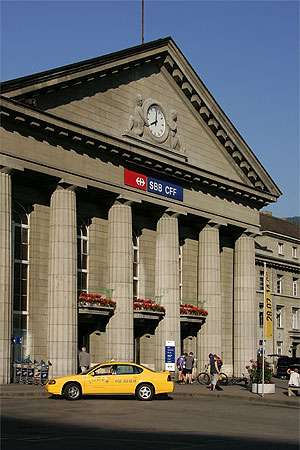
Main Train Station
-
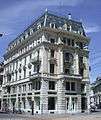
Jordi-Kocher House
-

Catholic parish church of St. Maria Immaculata
-

Kongresshaus (Convention Center)
-
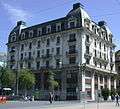
Kontrollgebäude at Zentralstrasse 45
-

Museum Neuhaus
-

Museum Schwab
-
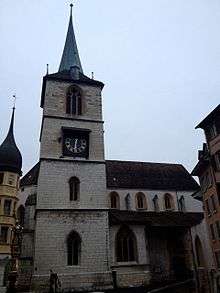
Swiss Reformed City Church
-

Administration Building and Montage Hall for General Motors
-

Volkshaus Building
-

Waldleute Zunft Building
-
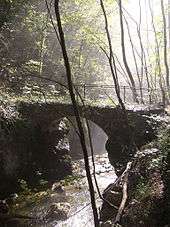
Bridge in Taubenlochschlucht
World heritage site
It is home to the Vingelz / Hafen archaeological site. Vingelz / Hafen is a prehistoric pile-dwelling (or stilt house) settlements that is part of the Prehistoric Pile dwellings around the Alps UNESCO World Heritage Site.[22]
The Vingelz / Hafen site is buried under mud near the shore of Lake Biel. It is one of the best preserved sites on the lake and has had minimal research. Based on the limited studies done on the village, it was occupied around 2970-2820 BC and again in 2780-2695 BC. About 60 wood samples have been dendrochronologically dated. The site was discovered in 1874 by Eduard von Fellenberg while he was excavating a dug-out canoe. In 1985 a series of test borings identified the two archaeological layers with a total thickness of about 90 cm (2 ft 11 in). A text excavation in 1998 found textile remains and a complete axe handle and blade.[23]
Business
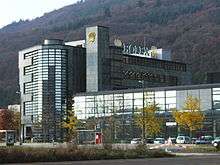
The city and its neighbourhood thrive on precision and micro mechanics, the conception and manufacture of highly specialised, production-oriented machinery and tools. The products are exported worldwide, next to Swiss-made watches of the well known and reputed watch brands in the city and its vicinity.
- Rolex have since the beginning established and run their movement and technical parts production centres in the city, also
- Swatch Group have their Group and several Brands headquarters, especially Omega SA and Swatch here, as well as
- The Federation of the Swiss Watch Industry FH
- Glycine Watch manufacturing and administration.
As of 2011, Biel/Bienne had an unemployment rate of 3.95%. As of 2008, there were a total of 33,799 people employed in the municipality. Of these, there were 56 people employed in the primary economic sector and about 10 businesses involved in this sector. 9,421 people were employed in the secondary sector and there were 451 businesses in this sector. 24,322 people were employed in the tertiary sector, with 2,267 businesses in this sector.[17]
In 2008 there were a total of 28,144 full-time equivalent jobs. The number of jobs in the primary sector was 43, of which 21 were in agriculture and 22 were in forestry or lumber production. The number of jobs in the secondary sector was 8,945 of which 7,405 or (82.8%) were in manufacturing and 1,388 (15.5%) were in construction. The number of jobs in the tertiary sector was 19,156. In the tertiary sector; 4,371 or 22.8% were in wholesale or retail sales or the repair of motor vehicles, 1,745 or 9.1% were in the movement and storage of goods, 1,092 or 5.7% were in a hotel or restaurant, 812 or 4.2% were in the information industry, 648 or 3.4% were the insurance or financial industry, 1,708 or 8.9% were technical professionals or scientists, 1,293 or 6.7% were in education and 3,591 or 18.7% were in health care.[24]
In 2000, there were 17,680 workers who commuted into the municipality and 7,990 workers who commuted away. The municipality is a net importer of workers, with about 2.2 workers entering the municipality for every one leaving.[25] Of the working population, 31.2% used public transportation to get to work, and 37.8% used a private car.[17]
Education

In Biel/Bienne about 17,768 or (36.5%) of the population have completed non-mandatory upper secondary education, and 5,492 or (11.3%) have completed additional higher education (either university or a Fachhochschule). Of the 5,492 who completed tertiary schooling, 56.6% were Swiss men, 26.4% were Swiss women, 10.5% were non-Swiss men and 6.5% were non-Swiss women.[18]
The Canton of Berne school system provides one year of non-obligatory Kindergarten, followed by six years of Primary school. This is followed by three years of obligatory lower Secondary school where the students are separated according to ability and aptitude. Following the lower Secondary students may attend additional schooling or they may enter an apprenticeship.[26]
During the 2009-10 school year, there were a total of 5,733 students attending classes in Biel/Bienne. There were 27 kindergarten classes with a total of 497 students in the municipality. Of the kindergarten students, 36.2% were permanent or temporary residents of Switzerland (not citizens) and 66.0% have a different mother language than the classroom language. The municipality had 79 primary classes and 1,470 students. Of the primary students, 32.9% were permanent or temporary residents of Switzerland (not citizens) and 53.4% have a different mother language than the classroom language. During the same year, there were 53 lower secondary classes with a total of 981 students. There were 23.6% who were permanent or temporary residents of Switzerland (not citizens) and 29.6% have a different mother language than the classroom language.[27]
As of 2000, there were 3,008 students in Biel/Bienne who came from another municipality, while 517 residents attended schools outside the municipality.[25]
Biel/Bienne is home to 3 libraries. The Stadtbibliothek Biel, the BFH Technik und Informatik TI Biel and the BFH Architektur, Holz und Bau AHB Biel. There was a combined total (as of 2008) of 233,171 books or other media in the libraries, and in the same year a total of 501,646 items were loaned out.[28]
Culture
The newspapers Bieler Tagblatt and Journal du Jura as well as the only totally bilingual German/French newspaper Biel-Bienne with its large free distribution within the greater area, are published in Biel.
The domicile of the Theater Biel Solothurn is situated in the old town.
The city is also known for its annual International Chess Festival.
The city of Biel received the Wakker Prize in 2004.
Each June since 1959, Biel has hosted a 100 km Ultramarathon race, which is among the biggest races of its kind worldwide and forms a part of the European Ultramarathon Cup.
Sport
- EHC Biel, the professional ice hockey team
- FC Biel-Bienne, the football club.
Notable people
Honoured Citizen
- Nicolas G. Hayek, promoted to honourable citizenship in 2004, official ceremony held on February 19, 2005.[29]
Born in Biel/Bienne
- Marcel Fischer (1978) - Olympic champion in fencing
- Thomas Jordan (1963) - chairman of the Swiss National Bank
- Ernst Thomke (1939) - businessman
- Robert Walser (1878) - writer
- Andréa Zimmermann (1976) - mountaineer
Gallery
-
Lake Biel
-
town's park
-
the river Suze
-
-

Place du Ring
-
-

See also
References
- 1 2 Arealstatistik Standard - Gemeindedaten nach 4 Hauptbereichen
- ↑ Swiss Federal Statistical Office - STAT-TAB, online database – Ständige und nichtständige Wohnbevölkerung nach institutionellen Gliederungen, Geburtsort und Staatsangehörigkeit (German) accessed 30 August 2016
- 1 2 "Nomenklaturen – Amtliches Gemeindeverzeichnis der Schweiz" (in German). Retrieved 4 April 2011.
- ↑ "Entwicklung der Städte und Agglomerationen". Swiss Federal Statistical Office. Retrieved August 12, 2012.
- ↑ Vingelz in German, French and Italian in the online Historical Dictionary of Switzerland.
- ↑ Mett in German, French and Italian in the online Historical Dictionary of Switzerland.
- 1 2 3 4 5 6 7 8 9 Biel/Bienne in German, French and Italian in the online Historical Dictionary of Switzerland.
- ↑ Amtliches Gemeindeverzeichnis der Schweiz, Ausgabe 2006, S. 271
- 1 2 Swiss Federal Statistical Office-Land Use Statistics 2009 data (German) accessed 25 March 2010
- ↑ "Climate Norm Value Tables". Climate diagrams and normals from Swiss measuring stations. Federal Office of Meteorology and Climatology (MeteoSwiss). Archived from the original on 14 May 2013. Retrieved 30 January 2013. The weather station elevation is 433 meters above sea level.
- ↑ Flags of the World.com accessed 12-August-2012
- 1 2 3 "Conceil municipal" (official site) (in French and German). Biel/Bienne, Switzerland: Biel/Bienne. 2016. Retrieved 2016-11-17.
- ↑ "Conseil de ville" (official site) (in French and German). Biel/Bienne, Switzerland: Stadt Biel/ Ville de Bienne. Secrétariat du Conseil général. Retrieved 2016-11-17.
- ↑ "Wahlen / Elections Biel-Bienne 2016: Stadtrat / Conseil de ville" (official site) (in French and German). Biel/Bienne, Switzerland: Stadt Biel/ Ville de Bienne. Retrieved 2016-11-17.
- ↑ Swiss Federal Statistical Office 2011 Election Archived November 14, 2013, at the Wayback Machine. (German) accessed 8 May 2012
- ↑ Swiss Federal Statistical Office - STAT-TAB, online database – Ständige und nichtständige Wohnbevölkerung nach institutionellen Gliederungen, Geburtsort und Staatsangehörigkeit (German) accessed 30 August 2016
- 1 2 3 4 5 Swiss Federal Statistical Office Archived January 5, 2016, at the Wayback Machine. accessed 12-August-2012
- 1 2 3 4 5 STAT-TAB Datenwürfel für Thema 40.3 - 2000 Archived August 9, 2013, at the Wayback Machine. (German) accessed 2 February 2011
- ↑ Swiss Federal Statistical Office STAT-TAB - Datenwürfel für Thema 09.2 - Gebäude und Wohnungen Archived September 7, 2014, at the Wayback Machine. (German) accessed 28 January 2011
- ↑ Swiss Federal Statistical Office-Rental prices 2003 data (German) accessed 26 May 2010
- ↑ "Kantonsliste A-Objekte". KGS Inventar (in German). Federal Office of Civil Protection. 2009. Archived from the original on 28 June 2010. Retrieved 25 April 2011.
- ↑ UNESCO World Heritage Site - Prehistoric Pile dwellings around the Alps
- ↑ palafittes.org UNESCO nomination files-Volume II: Id-files of the component parts of the serial, Sites Switzerland (2) accessed 12-August-2012
- ↑ Swiss Federal Statistical Office STAT-TAB Betriebszählung: Arbeitsstätten nach Gemeinde und NOGA 2008 (Abschnitte), Sektoren 1-3 Archived December 25, 2014, at the Wayback Machine. (German) accessed 28 January 2011
- 1 2 Swiss Federal Statistical Office - Statweb (German) accessed 24 June 2010
- ↑ EDK/CDIP/IDES (2010). Kantonale Schulstrukturen in der Schweiz und im Fürstentum Liechtenstein / Structures Scolaires Cantonales en Suisse et Dans la Principauté du Liechtenstein (PDF) (Report). Retrieved 24 June 2010.
- ↑ Schuljahr 2010/11 pdf document(German) accessed 4 January 2012
- ↑ Swiss Federal Statistical Office, list of libraries (German) accessed 14 May 2010
- ↑ http://www.biel-bienne.ch/ww/fr/pub/home.cfm?setlang=fr
External links
| Wikimedia Commons has media related to Biel/Bienne. |
- Official website of Biel/Bienne
- Tourism Biel Seeland
- Biel/Bienne in German, French and Italian in the online Historical Dictionary of Switzerland.
- Biel International Chess Festival
- Federation of the Swiss Watch Industry FH
- Chamber of economy Biel-Seeland
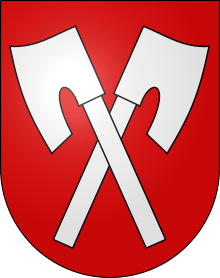

.jpg)